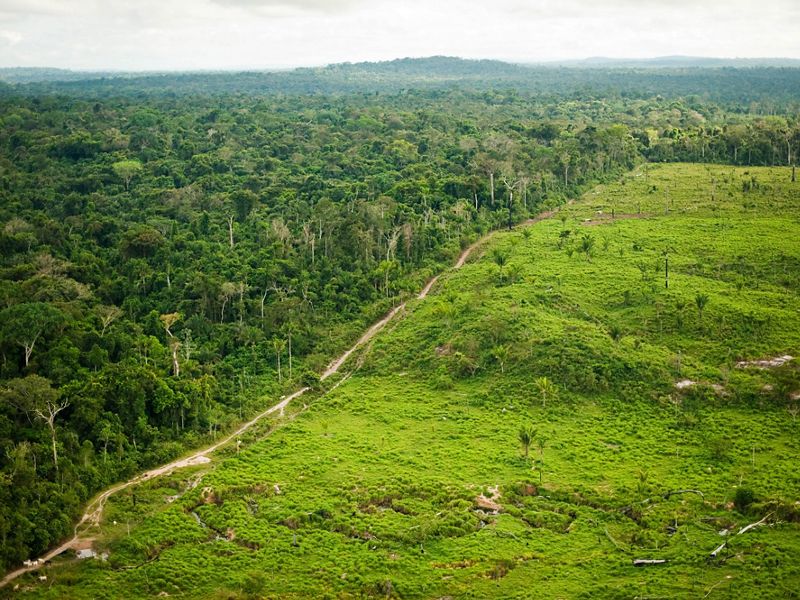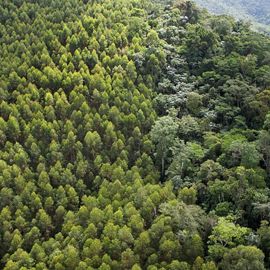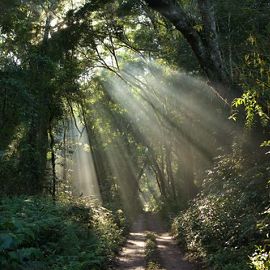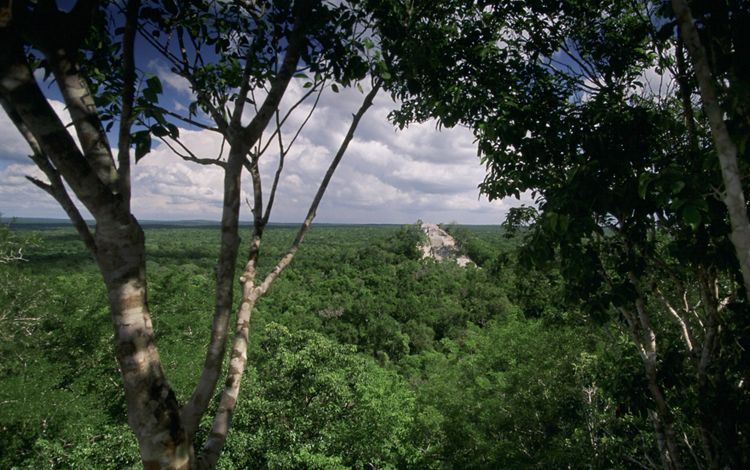
São Félix do Xingu, Brazil An aerial view showing deforestation for cattle ranching at São Félix do Xingu, a municipality in the Brazilian Amazon, that has one of the highest rates of deforestation in the country. Understanding that conversion to agriculture and cattle ranching is the greatest threat to the Amazon rainforest, the Conservancy works in strategic municipalities of the Brazilian Amazon such as São Félix do Xingu to implement strategies to control deforestation and promote the responsible production of soy and beef among farmers and ranchers. São Félix do Xingu is also one of the focal areas for the Conservancy's work on demonstrating how REDD programs can work on the ground. © Haroldo Palo Jr.
Brazil is home to some of the world's most vital and diverse forest ecosystems. These forests are not only crucial for the survival of countless plant and animal species, but they also play a significant role in regulating the global climate, storing carbon, and providing fresh water. Unfortunately, deforestation has severely impacted these areas, leading to loss of biodiversity, disruption of water cycles, and increased carbon emissions.
Our Tree Planting Efforts in Brazil
The Nature Conservancy and its PLant a Billion Trees program are committed to restoring Brazil's forests. Our efforts focus on the Atlantic Forest and the Cerrado, two of Brazil's most threatened ecosystems. We work closely with local communities, governments, and other organizations to ensure that our reforestation projects are sustainable and beneficial for both people and nature.
In the Mantiqueira Mountains, part of the Atlantic Forest, we have trained more than 600 people on restoration techniques and strengthened the work of seed collectors from rural communities. These collectors gather native seeds used for restoration, ensuring that the reforestation process supports local biodiversity. Increasing local capacities in restoration, and enhancing restoration supply chains are key elements to ensure restoration happens.
Will you help us restore Brazil's forests?
Plant Your TreeBrazil is home to some of the world's most vital and diverse forest ecosystems. These forests are not only crucial for the survival of countless plant and animal species, but they also play a significant role in regulating the global climate, storing carbon, and providing fresh water. Unfortunately, deforestation has severely impacted these areas, leading to loss of biodiversity, disruption of water cycles, and increased carbon emissions.
Our Tree Planting Efforts in Brazil
The Nature Conservancy and its PLant a Billion Trees program are committed to restoring Brazil's forests. Our efforts focus on the Atlantic Forest and the Cerrado, two of Brazil's most threatened ecosystems. We work closely with local communities, governments, and other organizations to ensure that our reforestation projects are sustainable and beneficial for both people and nature.
In the Mantiqueira Mountains, part of the Atlantic Forest, we have trained more than 600 people on restoration techniques and strengthened the work of seed collectors from rural communities. These collectors gather native seeds used for restoration, ensuring that the reforestation process supports local biodiversity. Increasing local capacities in restoration, and enhancing restoration supply chains are key elements to ensure restoration happens









Planting Trees Across Latin America Explore the map by clicking on locations to learn more about our planting sites.
Critical Forest Landscapes in Brazil
The Atlantic Forest and the Cerrado are essential to Brazil's environmental health, yet they have been heavily deforested. The Atlantic Forest, for example, has lost over 85% of its original cover. This deforestation has led to habitat loss for many species, reduced water quality, and increased vulnerability to climate change. Reforesting these areas helps to restore ecological balance, improve water resources, and create economic opportunities for local communities.
The Cerrado, known as the richest savanna in the world, is home to thousands of plant and animal species and the headwaters of Brazil's most important rivers. Deforestation in the Cerrado threatens these species and water sources. By planting trees, we can help protect this unique ecosystem and ensure the survival of its biodiversity.





